Why Hypercard Had to Die
Update: Click here if you would like to try HyperCard yourself.

Hypercard (version 2.4.1.) "Home" card.
I was a Hypercard child - though our friendship was brief.
Our seventh-grade class was led into a room full of brand-new Macintosh Performas. The day's lesson was a crash course in the use of an uncomplicated yet marvelous program. With it, one might persuade a computer to do anything and everything - or so it seemed to a child with the attention span to appreciate the wonder. Half a dozen of us were invited back a week later; and then again, and again, for several delicious months.
Among these pupils, I was the only one who had already dabbled in programming. Compared to the familiar ROM BASIC of my family's second-hand Commodore 64, the HyperTalk language seemed clunky and comically verbose. And yet there was something magical, something oddly enthralling about Hypercard as a whole. The ease with which a mostly-blank screen could be turned into an interactive, living, breathing graphical toy of my own creation was astounding, exhilarating, and addictive.
After the final week, I and one other schoolboy were driven to a distant office building, where we were asked to present our unremarkable creations in front of a darkened lecture hall. The latter was full of somber-faced, suit-wearing adults idly tapping away on costly Apple portables. With their lukewarm applause, the adventure came to its rather boring end. Lacking true English fluency at the time, I never learned exactly who was behind this brief departure from the braindead routine of my early schooling. And without regular access to a Mac (given its expense, it may as well have been a Cray as far as my family was concerned) I could not return to this fascinating plaything. My development as a programmer continued as it had begun, almost entirely Mac-less and Hypercard-less.
Though almost unknown to the sniveling digital trendoids of today, HyperCard was and is one of the most loved software products ever created. It was quite possibly an inspiration for the World Wide Web. Among its satisfied users one could even find the rich and famous.
When Steve Jobs returned from exile to rule Apple again, he let HyperCard wither away and die. Why?
In order to answer this question, it is necessary to actually power up an old Mac (or an emulator) and try HyperCard on your own skin.
Even today, there is still a wealth of HyperCard-related material on the Net, but I was unable to find a compact "Hello World"-style walkthrough example. So I created one: a very basic "four function" calculator. The materials needed for this recipe were:
- Basilisk
- A copy of HyperCard
- (Optional) A HyperTalk manual. I fished mine out of a dumpster when I was an undergraduate student.
- Around half an hour of time. Most of it was spent arranging the screenshots and writing their captions.
Without further delay:
Create a new HyperCard stack:
Now give it a name and save it:
Now you have a fresh stack, with a blank card:
Create a field:
Double-click on it and give it the title "lcd":
Re-size the field to reasonable dimensions:
Create a button:
Double-click on it and then click on the Script button in the properties dialog:
Below is the HyperTalk script that we will attach to the numeric and operator keys of our calculator. It does only one thing: append the text of the button's name - be it a number or an operator - to the calculator's "screen." The name is going to be something like card button "5". So if we want to append the number five when the "5" key is pressed, we will need to take last whitespace-delimited word of the button name -- "5" -- and perform an "eval" on it, yielding the number 5. The "value of" operator is simply the HyperTalk equivalent of Eval.
Save the button's script:
We will give each button the appropriate name:
Copy the button as many times as needed to create the calculator's numeric keys. There is no need to change the buttons' scripts, only their names.
Create the operator keys in the same way:
Now, we will need an Equals key. Create a new button:
Give it the name "=":
Now, let's give it its script. We will need to use HyperTalk's Eval again:
Now let's actually try using the calculator. Switch to HyperCard's "finger" operation:
Now enter an arithmetic expression which makes use of all four arithmetic functions, and click the "equals" key:
The result will appear:
This is a quite useless calculator without a "Clear" key. Let's add one:
The script for the "Clear" key:
There is nothing surprising about what the "Clear" key does:
We now have a very simple four-function calculator.
Having seen what you just saw, do you now know why Steve Jobs killed HyperCard?
Well, you probably don't. And I don't either. Obviously the man is dead and will tell no tales. But perhaps we can figure out the "why."
Does anyone really believe that Mr. Jobs genuinely “thought you could do everything in Cocoa and ProjectBuilder that you could do with HyperCard” ? He was far too intelligent a man to believe any such thing. One may as well say that you could do everything with a magnetized needle and a steady hand that you could do with a text editor. Or that you could do anything with Roman numerals that you could do with Arabic numerals. Or that you could do anything in INTERCAL that you could do in Common Lisp. And so forth. Jobs was almost certainly familiar with HyperCard and its capabilities. And he killed it anyway. Wouldn't you love to know why?
Here's a clue: Apple never again brought to market anything resembling HyperCard.
Despite frequent calls to do so. Despite a more-or-less guaranteed and lively market.
And I will cautiously predict that it never will again.
The reason for this is that HyperCard is an echo of a different world. One where the distinction between the "use" and "programming" of a computer has been weakened and awaits near-total erasure. A world where the personal computer is a mind-amplifier, and not merely an expensive video telephone. A world in which Apple's walled garden aesthetic has no place.
What you may not know is that Steve Jobs killed far greater things than HyperCard. He was almost certainly behind the death of SK8. And the Lisp Machine version of the Newton. And we may never learn what else. And Mr. Jobs had a perfectly logical reason to prune the Apple tree thus. He returned the company to its original vision: the personal computer as a consumer appliance, a black box enforcing a very traditional relationship between the vendor and the purchaser.
Jobs supposedly claimed that he intended his personal computer to be a "bicycle for the mind." But what he really sold us was a (fairly comfortable) train for the mind. A train which goes only where rails have been laid down, like any train, and can travel elsewhere only after rivers of sweat pour forth from armies of laborers. (Preferably in Cupertino.)
The Apple of Steve Jobs needed HyperCard-like products like the Monsanto Company needs a $100 home genetic-engineering set.
The Apple of today, lacking Steve Jobs -- probably needs a stake through the heart.
Either way, expect no HyperCard (or work-alikes) from Apple. But how about other vendors? What about open-source projects? Nothing there, either. Oh, there is no shortage of attempts. And all of them are failures for the same reason: they insist on being more capable, more complexity-laden than HyperCard. And thus, none of them can readily substitute for it.
And if you think that XCode, Python, Processing, or the shit soup of HTML/Javascript/CSS are any kind of substitute for HyperCard, then read this post again. And if you continue to think so, then you might be an autistic typical software "engineer," and please don't waste your time commenting here. Sink back into the cube farm hellpit from whence you came.
Otherwise, sit down and contemplate the fact that what has been built once could probably be built again.
Corrections and Edits:
1. Steve Jobs did not kill the Lisp Machine version of the Newton, but did kill the entire Newton project.
2. All of the comments pointing out that HyperCard was already obsolete when Steve Jobs killed it are missing the point. Jobs deliberately killed its community by refusing to maintain the product or even release the source. He could have released the source to the welcoming hands of tens of thousands of enthusiasts. All of the modern HyperCard clones (all of them substantially more complex and therefore inferior to the original) do not add up to a HyperCard community. It is an elementary "tower of Babel" situation. "Critical mass" in user communities is a well-known phenomenon. I am sure that it was not unknown to Jobs. What he truly succeeded in killing was not so much the basic concept of HyperCard but the community.
3. The various HyperCard clones and HyperCard-influenced software lack HyperCard's radical simplicity and the resulting explorability. Explorability of the "master of all you survey" variety matters. All of the extra features in a more feature-rich system like SuperCard (or even VB) are not harmless. There is a fundamental difference, especially for a child, between a system which you can fully wrap your mind around and one with countless mystery knobs.
4. Everybody pushing Javascript, Python, Wx/Qt, Cocoa, and other abominations as "HyperCard replacements" simply does not remember being a child. And/or lacks a creative bone in his body. And/or is a malicious idiot.
May 2020 Update: Seems like many readers continue to miss the essential point, just as they did in 2011. Hypercard wasn't a gem of graphic design (1-bit colour, plain line graphics) or of programming language design (one of the many laughable attempts at "natural language programming") or of high-performance number crunching... but it was simple. I.e., the entire system was fully covered by ~100 pages of printed manual. It fit in one's head. (And did not take 20 years to fit-in-head, either, an intelligent child could become "master of all he surveys" in a week or two.) Where is the printed manual for the current MS VB, or the WWW's HTML/JS/CSS/etc stack (yes including all browser warts), or for any of the other proposed "replacements" ? How many trees would have to be killed to print such a manual, and would it fit in your house? Could you read it cover to cover, or would you die of old age first?

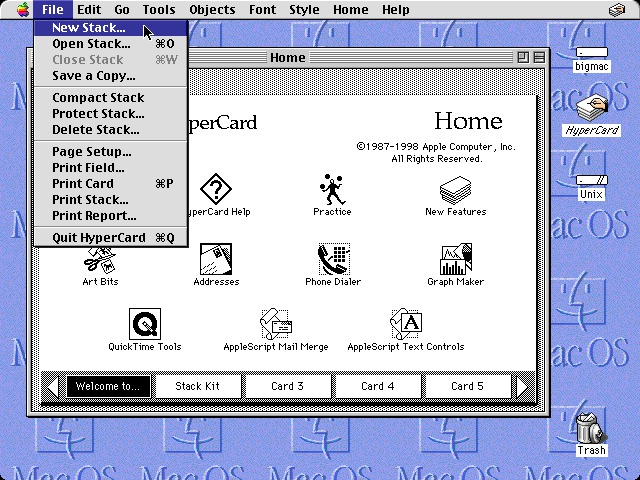
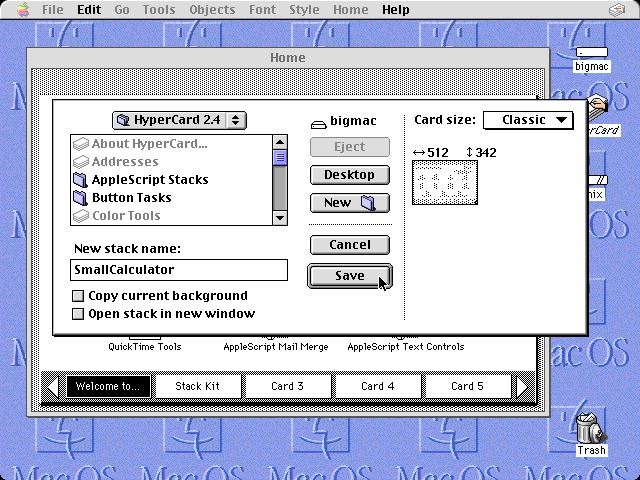
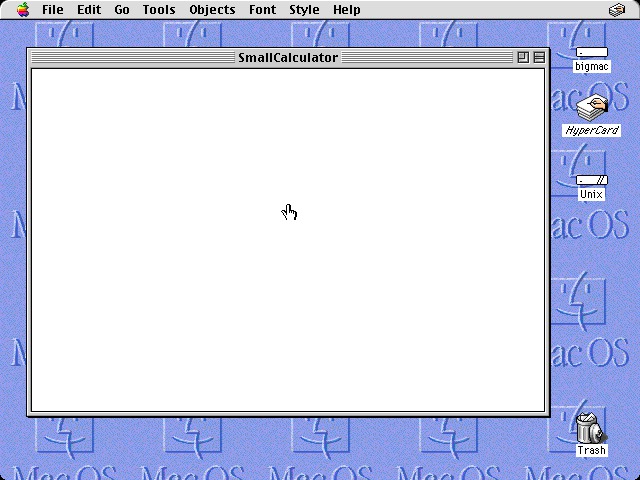
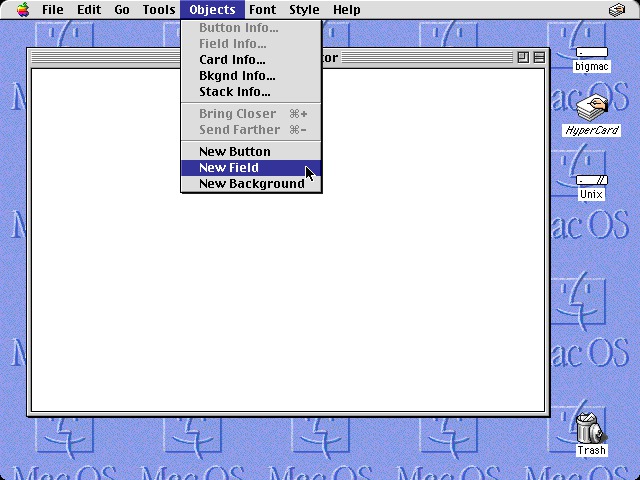
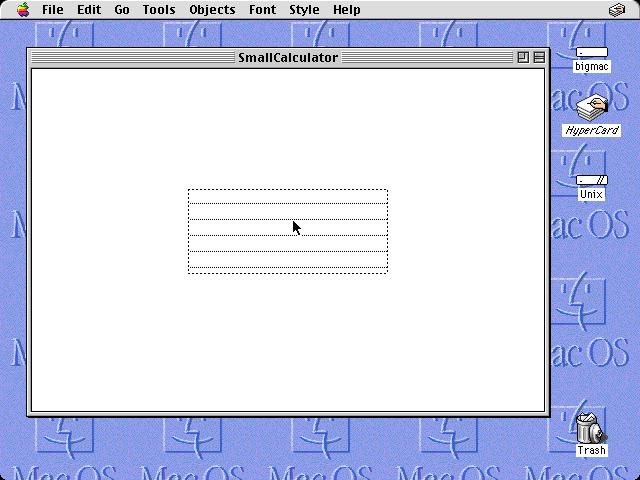
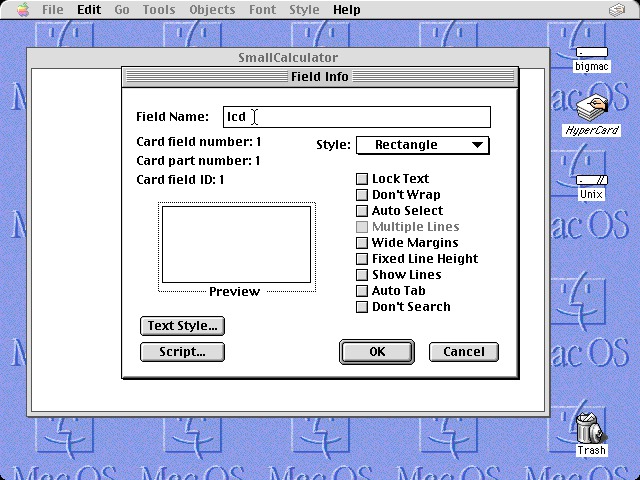
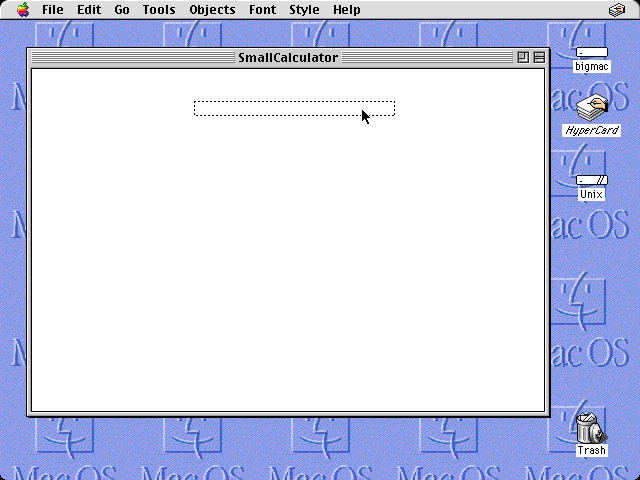
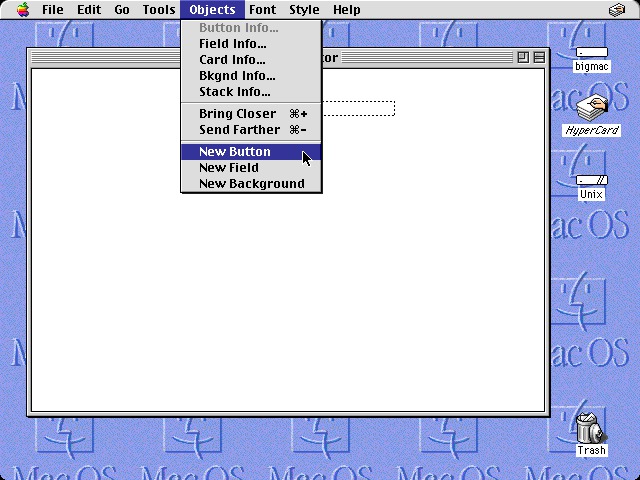
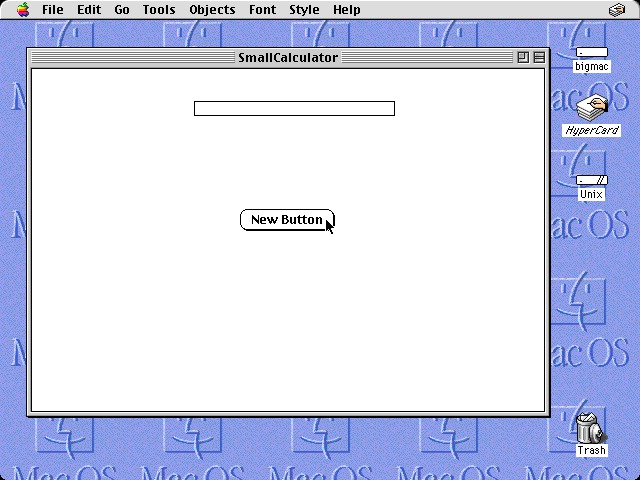
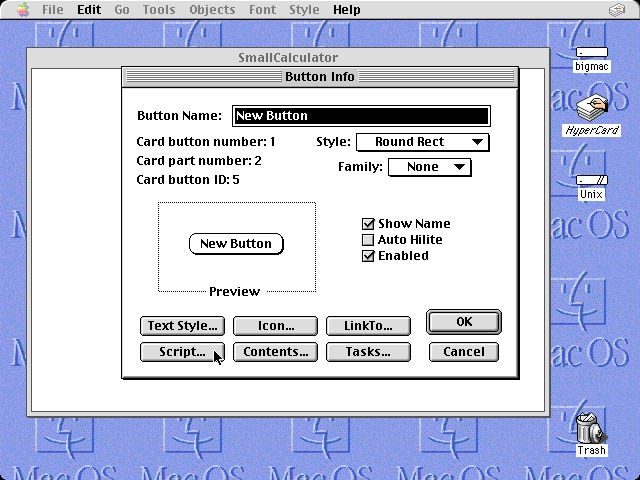
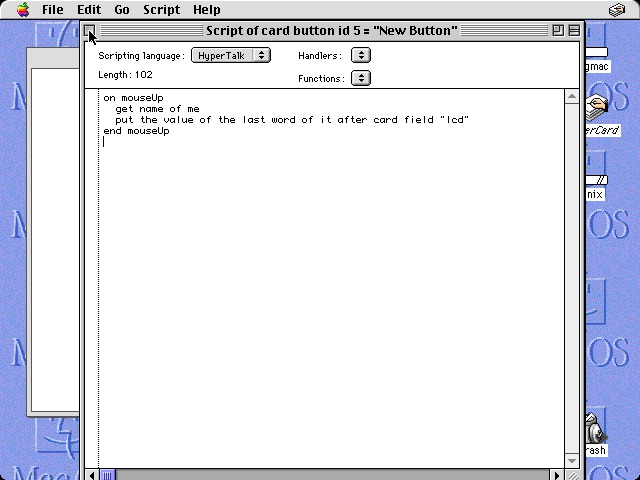
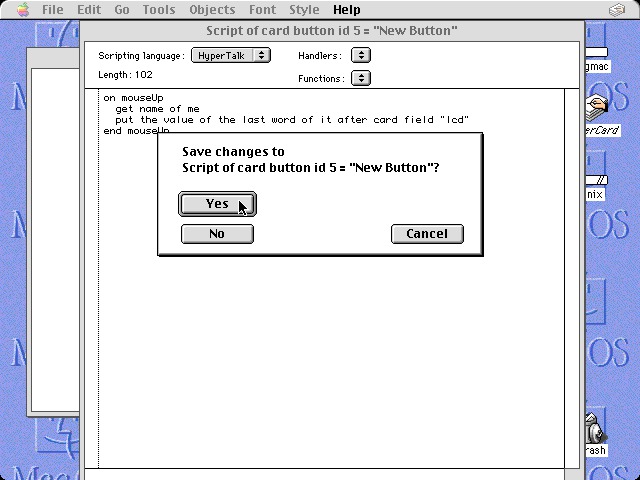
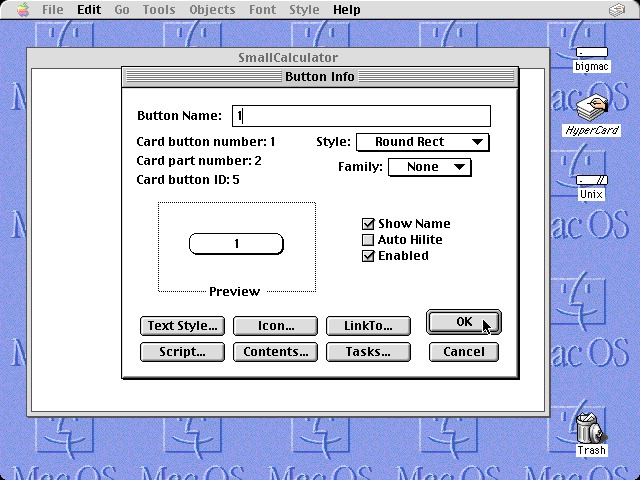
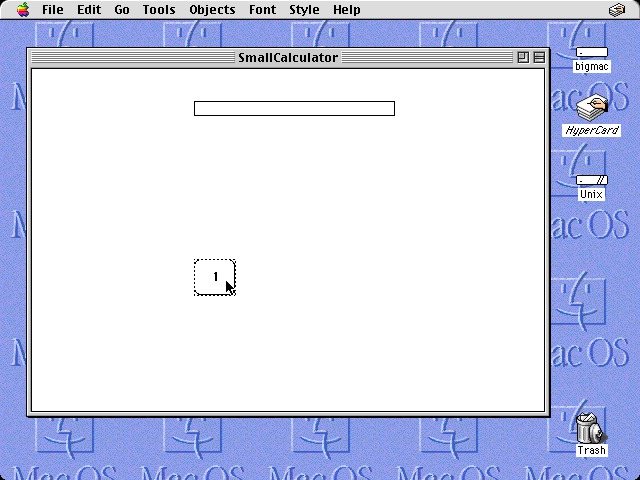
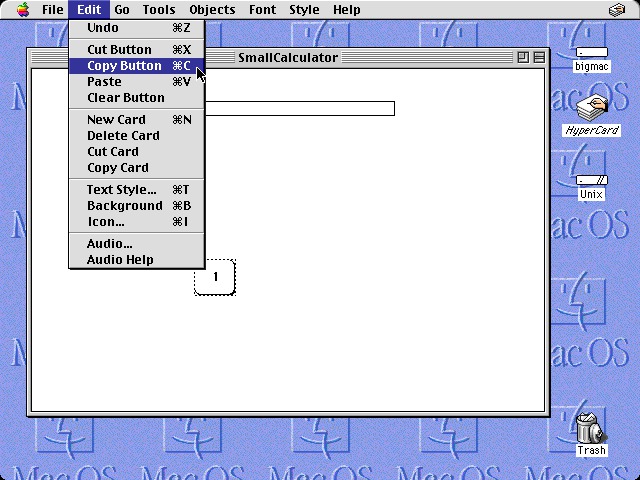
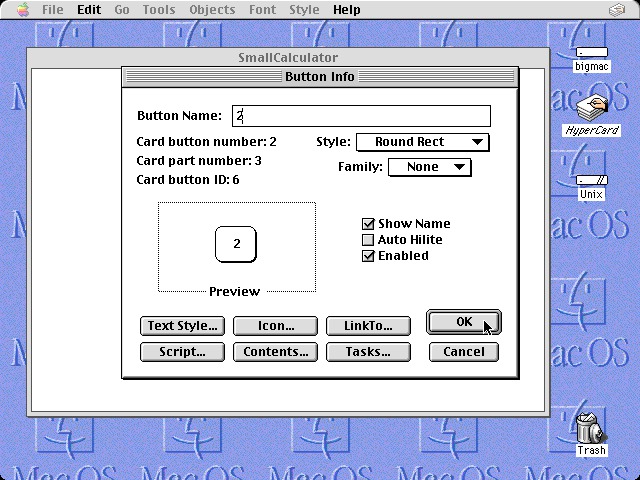
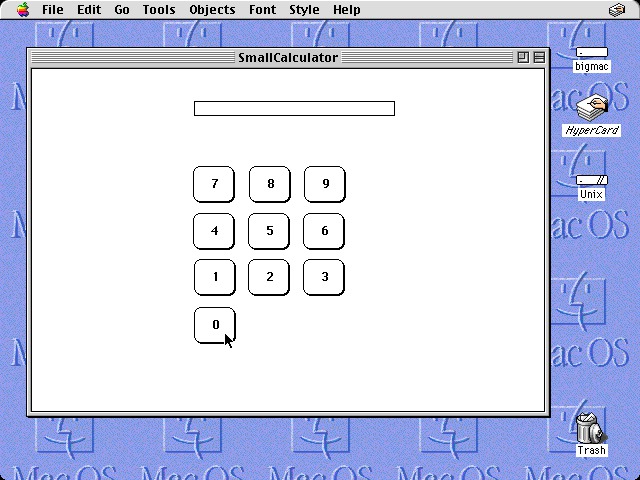
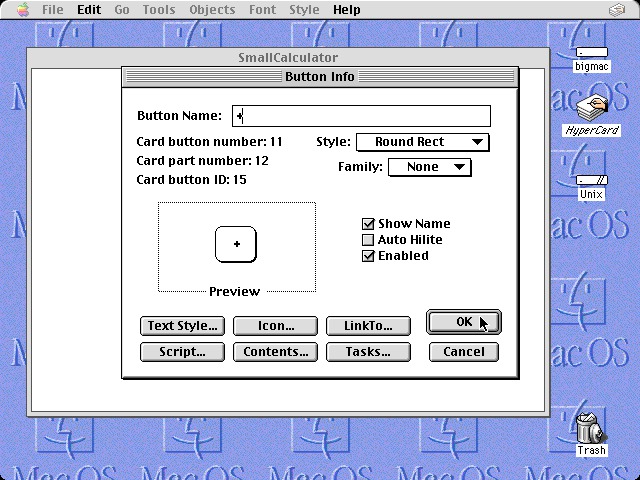
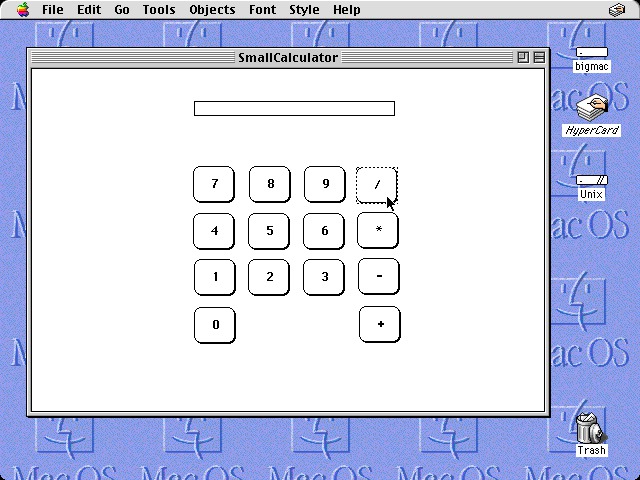
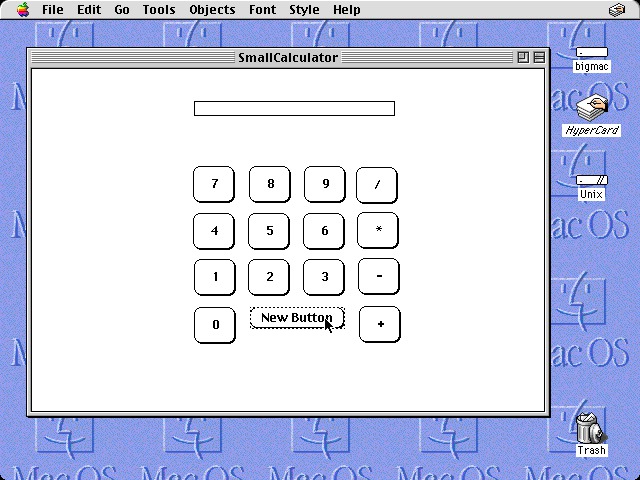
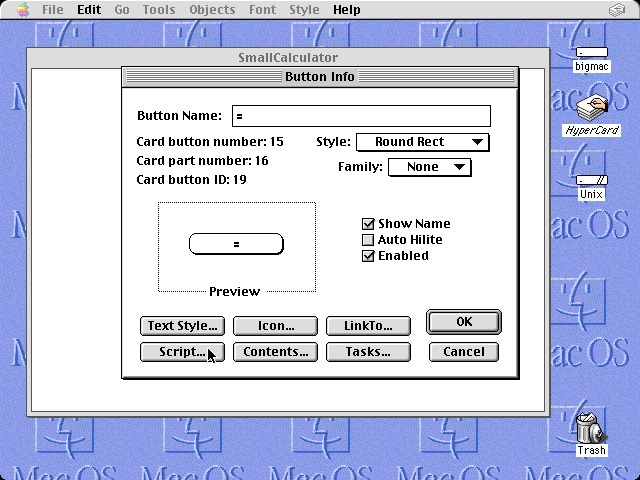
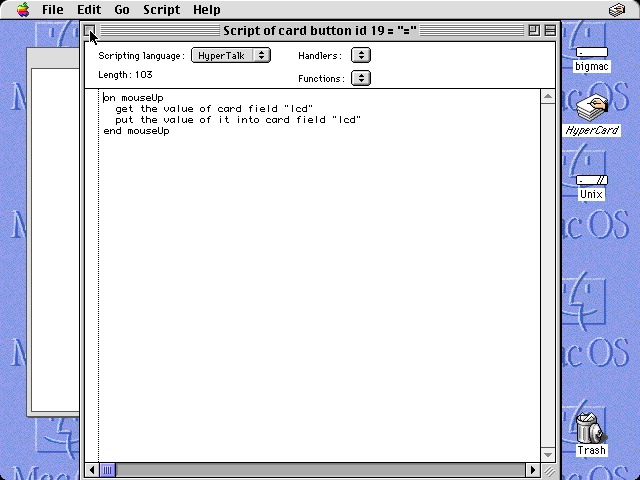
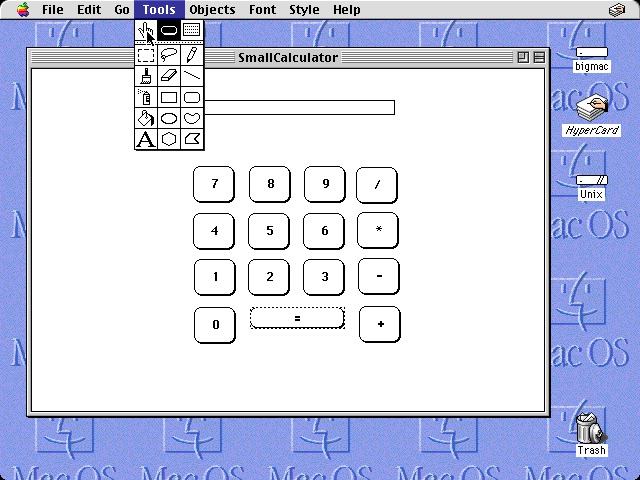
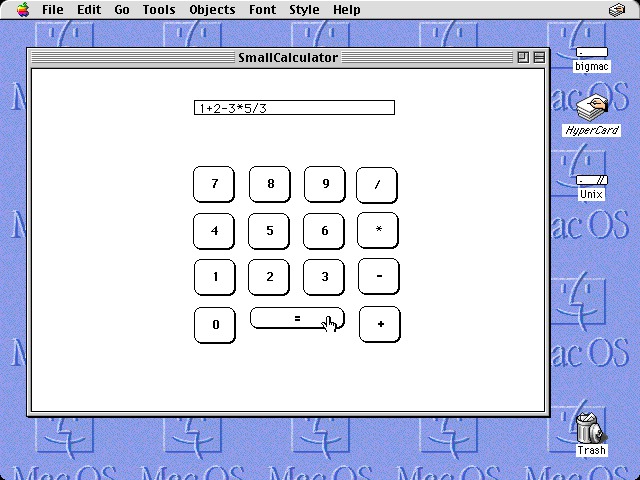
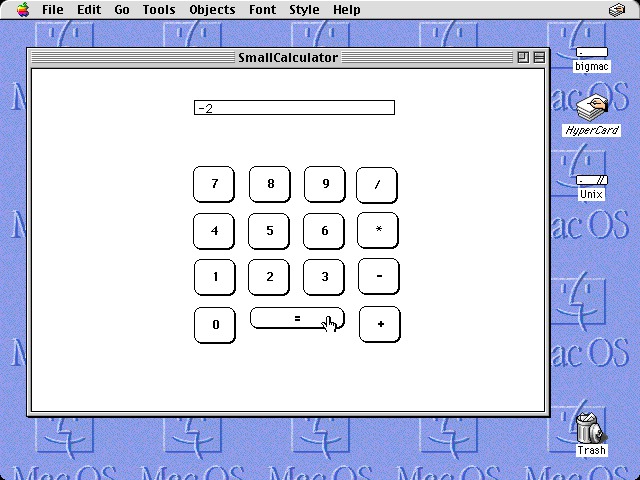
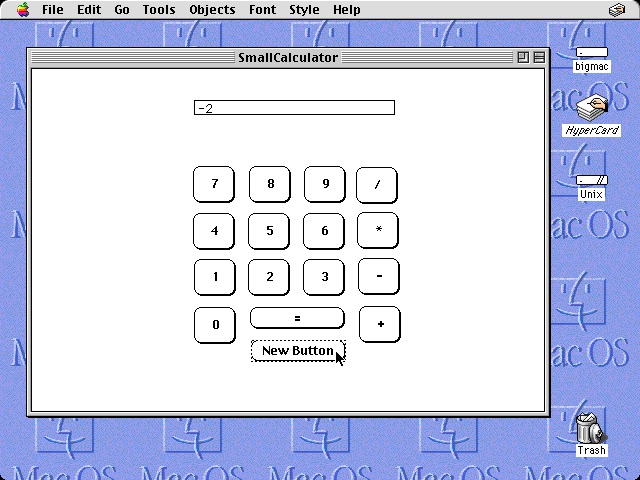
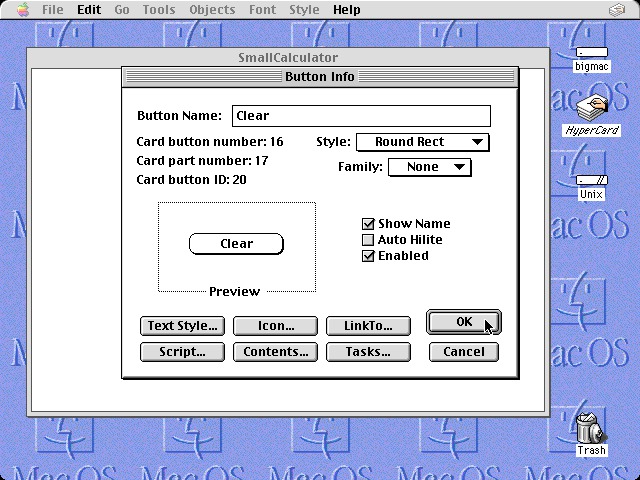
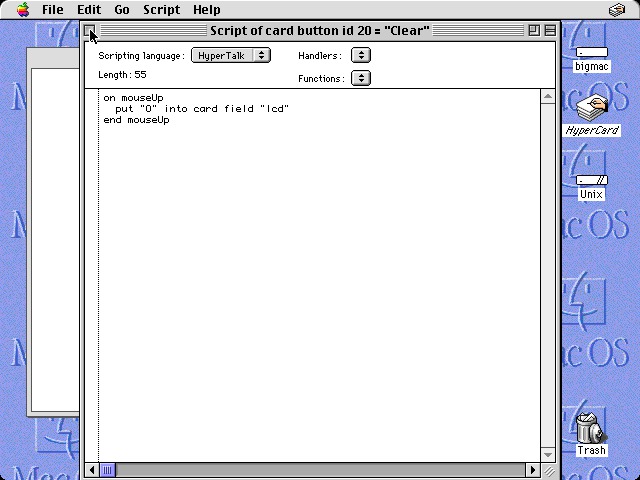
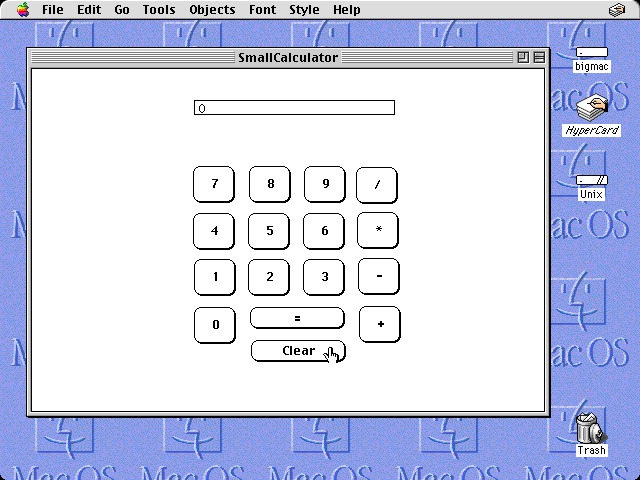


[...] year, and it prompted our own Steve Sande to reminisce about his experience with HyperCard as well. Speculation about why HyperCard was left to wither and die is also out there, as is a brief chat with creator Bill Atkinson about his feelings towards his [...]
[...] year, and it prompted our own Steve Sande to reminisce about his experience with HyperCard as well. Speculation about why HyperCard was left to wither and die is also out there, as is a brief chat with creator Bill Atkinson about his feelings towards his [...]
[...] year, and it prompted our own Steve Sande to reminisce about his experience with HyperCard as well. Speculation about why HyperCard was left to wither and die is also out there, as is a brief chat with creator Bill Atkinson about his feelings towards his [...]
[...] year, and it prompted our own Steve Sande to reminisce about his experience with HyperCard as well. Speculation about why HyperCard was left to wither and die is also out there, as is a brief chat with creator Bill Atkinson about his feelings towards his [...]
[...] year, and it prompted our own Steve Sande to reminisce about his experience with HyperCard as well. Speculation about why HyperCard was left to wither and die is also out there, as is a brief chat with creator Bill Atkinson about his feelings towards his [...]
[...] year, and it prompted our own Steve Sande to reminisce about his experience with HyperCard as well. Speculation about why HyperCard was left to wither and die is also out there, as is a brief chat with creator Bill Atkinson about his feelings towards his [...]
[...] [HyperCard:image] [...]
[...] The Apple of Steve Jobs needed HyperCard-like products like the Monsanto Company needs a $100 home g... [...]
You may be interested in my Google+ community "SVG Web Design - Beyond HTML"
I am releasing a step by step tutorial in using the "shit soup of HTML/Javascript/CSS" to emulate the core concepts of HyperCard.
I think you will find it interesting.
Ah, Hypercard. I remember those days. On PC, IIRC.
I'm reminded of how Flash (Pre-Actionscript 3) got me into my degree. The fact that I can make quick graphic objects with very light scripting was awesome...
But I see your point about kitchen-sink-y alternatives to Hypercard.
Though I have to ask, do you have a particular ordered list of how close they are to the ideal Hypercard solution? Perhaps along with criticisms?
When I 13 or 14 I learned BASIC, specifically QBASIC, and that was plenty graspable, in fact I wrote a calculator program a lot like this one when I was in junior high. Looking at the code you posted above, it looks straightforward, but it's also not that clear what it does. The verbosity, at least for me, hurts the readability, and the use of "it" is, well, really vague. I thought the code for the = button was actually pretty funny-- you're taking something out and then putting it back in, what's the point of that? Of course you explained that "the value of" evaluates an expression, and I probably could've figured it out, but a kid wouldn't know that and probably wouldn't have a basis for getting to the conclusion that's what that does. I have no idea how someone who's never programmed is supposed to come up with any of this besides the buttons. I also see a lot of buttons and controls and menus in the pictures above that you didn't talk about-- I've heard of HyperCard before and I've read up on it a little, but that's it, so these are "mystery buttons" to me. In fact I still have no idea why all of this is called a card or it's in a stack or what exactly that means or why it's helpful or necessary (it was some time ago when I read up on it). The point is that even with this setup there's a lot you'll have to explain to someone not familiar with programming. Aside from the click-and-drag placement and sizing of things, and picking things from a list, it really doesn't seem easier than other ways of doing this, and add-ons, extensions, IDEs, front-ends, and even whole dedicated programming languages are out there that make that possible now. I think either you picked a bad example or this was ahead of its time but not as revolutionary as you think.
Pick up a copy of Danny Goodman's The Complete HyperCard Handbook and read the first chapter. That will stop you moaning about things. Hypertalk is by far the easiest programming language that has ever existed. What is "it"? Well... perhaps you need a pair of glasses... or revise your logic-solving capacity. In one script you see the code: GET THE VALUE OF CARD FIELD "LCD"... and then the next line says PUT THE VALUE OF IT INTO CARD FIELD "LCD"
And yes, well... your comment, Sir, is ill-informed, and hence you jump to poorly based conclusions. The remark about the script in the "=" (equals sign)-button shows that your grasp of basic programming is also lacking. A break-down, just for you: The second line of the script calculates what you entered into the field and the result is automagically stored in the global variable "IT". And with the next line you put that calculated value back into the field called "LCD", hence removing the things you put into it with the buttons, replacing the result for it. Just like you would when hitting the "="-button on a REAL calculator. Try doing that in any other language with so little code.
Loved your article - as I was building the Austrian HyperCard Community 25 years ago. And I love your conclusion.
After HyperCard came SuperCard and MetaCard. MetaCard became LiveCode and runs on OS X, Win, Linux, iOS and Anroid. Now, LiveCode should become OpenSource, but to start, some help is nedded. See here:
http://www.kickstarter.com/projects/1755283828/open-source-edition-of-livecode
By the way: old HyperCard Stacks can be converted to LiveCode and an old adventure could go on…
Right on! Well MetaCard became Revolution then LiveCode and it did go OpenSource (there is a commercial version too), and it rocks better than ever!!! Now they're adding a secondary language called LCB to allow making extensions without the need for a different lower level language (finally replacing SDK XCMF/XFNC type glue code)!
I like reviving zombie threads 🙂
LiveCode IS the new HyperCard
They want to completely rewrite the code so it can be taken care of by a community. This is really a dream come true - I hope it gets some of the old elegant simplicity mentioned in teh article.
[...] wirklich in die Lage versetzt hätte den Computer selbst als ihr Werkzeug in die Hand zu nehmen, zu verhindern. Was die Mac-Community in den ersten Jahren von HyperCard erlebt hatte, war ein unglaublicher [...]
This was a really great article, other than the toxic bit calling people "autistic" near the end. :/ No ableism please.
Dear Annetta Gaiman,
Ephialtes says hello.
I believe that sight is better than blindness, hearing is better than deafness, and intelligence is better than stupidity. And that better is better than worse. And, should you care to ask, I voted against Mr. Obama, and enjoyed every second of it.
Now you are invited to go cry somewhere.
Yours,
-Stanislav
You are right , intelligence is better than stupidity, and intelligence is what you seem to be totally lacking if you believe that autists are autists because they want to. Or maybe the blind are blind because they don't want to see. Hopefully for you, stupidity is not fatal, and you may recover one day.
Yours truly.
Gengis Khan ( who says sissy white boy Ephialtes can go fuck himself )
Stanislav--
I'm a "high-functioning" autistic person. I have 45 years of experience with computers, many of which were in a museum before you and most of your readers were born, and I have a Ph.D. to boot!
Autism does not automatically imply retardation, as you seem to think.
Autistic people like me are different than "neuro-typical" people, it's true; like visual-spatial people are different than auditory-sequential people. There are many of use making important contributuions to society every day.
Was browsing through this classic post and had to say something—
I’m autistic. (Please note that I only speak for myself.) What I got from your use of “autistic” was that you were describing someone who is highly technical and detail-obsessed, and has difficulty connecting with people who aren’t. That’s just about the most accurate stereotype of autistic people I’ve ever seen (well, next to that My Little Pony episode where Twilight goes nuts because she can’t figure out what this week’s moral is supposed to be, that was awesome). So, we cool.
And Stanislav, since you brought it up, it’s now fair game: I voted for Obama AND Hillary, bwa ha ha ha ha! Fear my liberal powers 😉
Regarding releasing Hypercard's source code you have to remember that many programs from that time were written in 68k assembly and sometimes the compilers had bugs to where they would run on OS versions up to a certain point and then wouldn't compile on anything past that point.
For example, Appleton (the author of World Builder) had to use a ResEdit hack to get his program to run on 32-bit clean systems in 32-bit mode as the version of the compiler he used had a bug and a later versions of the same compiler wouldn't compile the code for some reason.
Similarly, Bill Atkinson said that Hypercard had more assembly language than QuickDraw and that quickly became an update nightmare as shown by the how you wound up using XMCDs to get around many of the limitations of hypercard.
Back when Copeland was still being planned an Apple representative explained to our local Mac Users Group that part of the problems was the System OS was filled with "black box" code that was the result of compiled code being patched after the fact--sometimes by code compiled in another language or worse via ResEdit.
So in the old days you wound up with code that no one really knew what it did thanks to patches via long defunct compilers or undocumented tweeks with ResEdit. It is possible hypercard was in this state and required a full rewrite to go into the future (as Duke Nukeum Forever showed demos don't mean anything).
By the time Jobs came back no one wrote in 68K assembly anymore and if it like Wotld Builder was dependent on bugs in a particular compiler that no longer existed then releasing the code couldn't have done anyone any good.
Dear Morgan,
These are good points, and they apply to a great many artifacts of that era. But the fact remains: Apple could have released whatever information might be helpful to those who wished to create a HyperCard-compatible system - format documentation, preserved code, etc. At the very least, they could have given legal blessing to the idea, instead of playing the "dog in the manger."
Yours,
-Stanislav
Regarding Apple providing whatever information might be helpful to those who wished to create a HyperCard-compatible system that is historical revisionism.
Supercard (1987) and MetaCard (1992) could both import Hypercard stacks so the format documentation, preserved code, etc were reasonably well known enough that a HyperCard-compatible system was able to be made BEFORE Jobs returned.
Moreover the problems those programs had with XCMDs and XFNDs in stacks showed where the REAL issue with Hypercard was...it required ANOTHER programing language to really use (Pascal or C). Nevermind, Hypercard AppleGS and Mac stacks were totally incomparable with each other showing that they weren't documents in the standard sense of the word.
So you had a program that was badly spaghetti coded running stacks that more often then not were equally spaghetti coded. No, this was no "dog in the manger" but rather "Rube Goldberg doing programing while buzzed out of his mind on a LSD-Jolt Cola-beer cocktail."
The fact that Apple itself was effectively doing Hypercard 3.0 as little more then yet another extension of Quicktime shows that they basically considered the original code a lost cause
I started using Hypercard in high school, when it was released, and throughout all 4 years of college studying computer science at NYU. It was beautiful, and powerful, and elegant, and was the fastest way to create desktop software. I still miss it -- the tools of today are amazing for professional programmers, but really don't address that middle ground.
I think Steve killed it because it just didn't fit in with his worldview. Apple didn't really make money off of hypercard -- Bill Atkinson actually made Sculley promise to not charge for it. (Apple eventually did at the ened of its lifecycle, but irrelevant..)
Hypercard was a hobbyist tool for a hobbyist software community. Jobs needed the mac to have professional tools for hobbyist media communities -- which was a good move for Apple's business. More people are into video and websites than stacks.
Releasing the code wouldn't have been that useful either, though I wish he had. The code was super-optimized for ancient macs in 2-bit color, crazy old processors, and thimbelfuls of memory. Trying to make it run on modern hardware would have required a total rewrite. It makes me sad that none of the rewrites have done well, though.
Thanks for this walk down memory lane. HC was an oldy but goody.
IMHO by the time Steve came back Hypercard had become so badly spaghetti coded that he was basically performing a mercy killing; technically version 2.0 (1990) was even LESS of a upgrade then System 8.0 was over 7.x. In fact the debugger as well as stack dependent XCMDs and XFCNs kludges to allow color and video to work had to wait until version 2.2
I should point out Hypercard was only free with a new Mac, otherwise you payed $50.00 for it. The problem is that it was the stacks that really separated the free and commercial versions so it was insanely easy to access Hypercard's full power without paying or messing around with the application itself.
If you look at what Jobs also got rid of (Newton, Cyberdog, and OpenDoc) it seems that he was focused on putting wasteful and ultimately dead end project out of their and everybody's else's misery.
[...] a recent episode of my favorite podcast–Hypercritical–John Siracusa talks about the death of HyperCard. HyperCard was an application on early MacOS that let you make your own programs, or stacks, via [...]
[...] years of HyperCard ► Why HyperCard had to die ► Like this:Like [...]
Excellent article. This expresses my own feelings about HyperCard and the wilful neglect from Jobs. Simply releasing what code there was and giving his blessing to open source development would have been a magnanimous act.
It seems to me that as apple have grown so their relationship to their user base has changed from the status of valued and enthusiastic partners to straight out the box consumers.
I cannot think of a single comparable piece of software that was so loved and supported for so many years and embraced so enthusiastically for its simplicity, accessibility and usability - that was allowed to die. Make no bones about it - Jobs killed HyperCard as blatantly as putting kittens in a bag and throwing them into a canal and then denying culpability.
Whatever HyperCard's imagined limitations its ability to open up programming to novices and enthusiasts remains unsurpassed its potential for creativity was unfulfilled .
Interestingly it was an article about another accessible rout to programming that led me to this page. A big move in education as of today .......
"Lorna and her classmates, who range in age from 4 to 7, are taking part in a pilot study here at Tufts University in Medford, Massachusetts, to see how young ScratchJr, a spin-off of the Scratch programming language. Scratch was invented to teach students as young as 8 how to program using graphical blocks instead of text. Now even children who haven't yet learned to read or write are getting in on the act."
"Tools like Scratch aim to address what their developers see as a lack of computer programming instruction in schools today."
HyperCard was the answer to that problem .
Apple continue to produce excellent product but they are evolving into another Microsoft. Steve Jobs saved "his" company but Apple should remember that it's fan base kept it breathing until jobs performed CPR
I remember the sheer fun of having the opportunity to actually put together working program's in HC.
From stacks to automate school reporting to an Alphabet Stack for my daughter incorporating a full colour paint program and spelling and number games. Great Fun.
Your article is spot on, as is your conclusion.
Paul Flockhart
Steve Jobs had been clear that he took decisions considering if the present day were the last to be lived fully then what must be achieved for fulfillment. Unfortunately during his exile from Apple the Web had already happened, so after returning he had to let go of Apple's side of hyperstuff for the Webkits for keeping integral vision ahead for Apple's developers.
He just declared, & had he been around the HyperCard certainly would have given tough time to HTML. HTML5 has audio & video objects & browsers have pdf flash plug-ins, all ripped-off from the basic notion of hypercards..
What a great article! It captures exactly the feeling I had with HyperCard. Oh how could HyperCard be the iPad killer app! Thanks for this article.
[...] shows the slightest bit of wear after which it will immediately look tacky and dated.2 Apple, since Steve Jobs killed hypercard, has been on a long path towards moving computers from useful tools into consumption devices not [...]
I think there may be a present-day tool vaguely like HyperCard in a completely different domain: RPG Maker.
RPG Maker has some of that magical feeling where a beginner can grab it and start whacking out a game using a hundred premade high-level objects and functions that allow for low-level tinkering, while never requiring it, as I understand to be some of the problem with the shit soup.
If I'm mostly focused on the story, I can toss in the generic Fighter and Mage characters, and RPG Maker will supply default names, portraits, and skills for these characters. If I want to edit any of these, or create my own characters from scratch, I can. If I want to make them change during the course of the game, I can do that too.
If I want to place a treasure chest (one of the most common events in your typical RPG), I can. But the "treasure chest" in RPG Maker is a composite of icons, script, and numbers that can be edited so that the treasure chest might contain more or less gold, refill itself over time, disappear on being opened, or use slightly different graphics, and each of these can be modified separately by me without my having to concern myself with the others - or I can concern myself with exactly none of them, and place a treasure chest containing a healing potion in mere seconds.
Perhaps I'm on a tangent now, but I find it very good that the Easy-Bake Treasure Chest isn't a hard-coded, special doodad for use by idiots, but is a normal doodad of the sort one might make if creating a treasure chest out of regular code events, and when analyzed, breaks down into the usual modular components.
[...] The Apple of Steve Jobs needed HyperCard-like products like the Monsanto Company needs a $100 home g... [...]
I use and program HyperCard on a daily basis on my Macintosh with native Mac OS 9.2. There is no replacement. I have tried them all. In an effort to move past hypercard, I taught myself JavaScript, HTML, CSS and RE. I even made a stack that converts a card into an HTML page. The beauty of HyperCard is that it can be programmed to convert itself. My converter even translate HyperTalk into JavaScript. The calculator example you made is an easy translation that works out of the box. HyperCard would have been dead if it continued to evolve. HyperCard is still alive on my Machines!
[...] that run further software that they can't vet.LoperOS has some good speculation : http://www.loper-os.org/?p=568Embed QuoteUpvote • Comment Loading... • Just now Add your answer, or answer [...]
I started working with HyperCard in 1990 in late middle school. I soon took a liking to programming it. It was the reason I wanted my parents to buy me a Mac. I moved on after school still in love with Apple, the Mac OS, and HyperCard. Supercard just didn't cut it. I got a job nearly two decades ago working for a small mail order company that barely made a million in sales. This company had no computers at all. Within a year I had singlehandedly computerized the entire company with HyperCard. Initially it was shipping, then customer database, then invoicing, then accounting. In 2000 we started a website and I used HyperCard for that with the help of a cool product called LiveCard, which dynamically served your stacks over the web. It worked pretty good. Today HyperCard has built that small company into two corporations each with annual sales in the quarter billion. HyperCard still serves our customer database, invoicing, shipping, accounting, payroll, and government record filing. I've developed the only government-certified HyperCard version of the post office mailing software including barcode generation and printing. Some functions have been offloaded to Linux servers running Runtime Revolution and LiveCode. When HyperCard is given too much load to a dual-core G5 running OS 9.2 I convert the scripts to revolution and execute them on the Linux server and return the result to my stacks via HyperHTTP XCMDs. HyperCard is still the gears powering hundreds of millions of dollars annually at my company. As long as our bank of G5 machines holds out we will always find a use for HyperCard.
Sounds all good but I fear that's why Jobs let it die, the arse.
You've clearly used it for what it was made for and I'm sure Bill Atkinson would be pleased to see it's use. Unfortunately for everyone else Steve Jobs wanted to control everything and everyone. I guess that's why he let it die so he could sell you the system you made yourself with Hypercard.
It's a shame because although I hate Apple, Hypercard did look really useful.
Although I hate Apple and never liked Jobs (even more so after reading his book), I've been watching the old Computer Chronicles episodes and the HyperCard ones popped up. Having done programming before but having also grown bored of it I thought Hypercard looked great. It would be great for kids today in school but also everyone.
I've just searched for an alternative, can't believe there isn't one it's madness. I can see why Jobs let it die. Him being the controlling arse he was I assume didn't want people writing their own mini apps with it.
Its surprising none of the generous of phone app developers haven't thought of making a clone, they'd rake it in if they sold it real cheap. But then no doubt Apple would come a long and sue them for copyright and lost earnings, ignoring the fact they haven't used or sold Hypercard or any clone in years.
eh. the various replacements that are actually HC-like look fine to me.
Roger Wagner's HyperStudio is aimed at K-12 audiences and does an excellent job of keeping the key attributes of HyperCard enumerated here alive and well. I'd really like to know whether you think so too and why or why not.
The re-making of HyperCard at Apple may be coming in the very subtle form of Automator, AppleScript, iBooks Author and iAd Producer which can develop HTML widgets for iBooks Author w/o coding.
Finally, HyperStudio is able to produce HTML web apps/o coding and HyperStudio Author is able to export TML widgets for iBooks Author.
Thus, the ghost of HyperCard is still here with us because there is still a hunger among non-programmers to be able to make things with their computers that are interesting or useful. There is even a HyperArduino aspect of HyperStudio for the K-12 "maker movement."
What we need to consider is the difference between "interactive before the Internet" and "interactive after the Internet".
The web browser became the only legitimate viewport through which to have interactive experiences. The mobile device became only only other legitimate viewport.
This was a relatively lo-fi experience in comparison to what we had in the early 1990s. But the Internet prevailed not by quality, but by quantity. All business models changed toward "number of views", "number of clicks", and we have what we have now.
Ask anyone in the software world today, if a desktop application with "interactive content" makes business sense if it can't be delivered through a browser window. You will get a unanimous "no". It's better to make ten million people skim over a page of broken crap for a fraction of a second, than to sell some media to a few paying customers.
I used Hypercard in Highschool just for mind-mapping. There is absolutely nothing on the market today that will in a very simple and intuitive way let me create simple note cards and organize them into stacks. Yes, there are programs like evernote and Onenote but they lack the simple elegance that hypercard had and still don't really accomplish what I want.
I just want to take historical notes like: 55 Million ago: Mammals first appear on earth. 10,0000 BC Modern Humans appear: 2016: David Bowie Dies. Now take all my cards and order by time-line.
So simply but I can't find a single app anywhere that will let me do this! So stupid I'm about to go back to paper notecards.
If I were a developer I would make a new hypercard--it would be my life's mission.
Morgan said:
>> IMHO by the time Steve came back Hypercard had become so badly spaghetti coded that he was basically performing a mercy killing
This is rank speculation. The state of the source code of HyperCard 2.x was irrelevant to the decision of whether or not to proceed with a reimplementation.
Could you maybe not use autistic as an insult?
Dear Andrew,
You are cordially invited to go and pound sand.
Yours,
-S
You have a historical error here. I was on the HC team when it was killed. It was killed when Claris was returned to Apple in 1992, long before Steve Jobs returned (1997). This is the reason I left the team. The official reason given to us by the execs was "there is no way to make money on a product we give away for free". I believe that Jean Louis Gassee was the man mover behind this despite opposition from John Sculley who was on his way out anyways. It was part of J.L. general attempt to kill all multi-media work at Apple. I believe he was paving his way to BeOS and wanted to destroy the competition.
Dear David Minor,
Interesting. Although I would still give Jobs "credit" for the final bullet in the product's head -- given as he studiously ignored a decade+ of offers to buy, open source, or in any other way revive Hypercard.
The "no way to make money on a product we give away for free" supposition doesn't pass the laugh test -- Hypercard was a Mac-only program and directly creditable for some large (if unknown to archaeologists) number of machine sales.
Yours,
-S
As I pointed out before Hypercard was written in 68000 assembly do so just [i]who[/i] was going to buy a program written in such an narrow and archaic programing language?
This is ignoring the XMCDs and XFCNs that had been added in stacks to expand on what the program could do which would [i]also[/i] need to be rewritten.
Supercard and MegaCard were still working in 1997 so why put resources into a program when they could be better put into cleaning up the mess the OS was in?
Never mind that MegaCard went open source around 2003 when Revolution was produced and that became LiveCode in 2013. But an open source of that program didn't come into being until 2015.
Hey,
I just created a post showing a modern day hypercard. I recreated your demo there:
https://andregarzia.com/2019/07/livecode-is-a-modern-day-hypercard.html
Thought you might enjoy it.
Dear Andre Alves Garzia,
Looks to be a fairly faithful clone (and someone already mentioned it earlier.)
However apparently the author, like many other "let's make new Hypercard" people, succumbed to the temptation to add ten thousand knobs for various "modernisms" (e.g. SVG), in the process losing the master of all you survey simplicity of the original.
Yours,
-S
I saw Hypercard in use at one of my clients in the late 1980s. Programming by example at its finest. I never understood the name, as it sounded like hardware which could go next to the sound board if you had enough remaining slots on a 386 motherboard.
There is the separation of church and state, and with Apple, it was the separation of user and developer (or vendor).
The one language which approached Hypercard, for me, was Smalltalk-V. With roots from Xerox Parc, the steps to do a desk calculator were rather almost identical, the code fragments themselves were ideologically similar, but most important was the explorability aspect, missing practically everywhere else. Much of the language was right there for you to tinker with and explore, to the extent that you could easily render the system inoperative.
But I never saw even an interactive repl-like langauge for the iPhone.
Very interesting.
Recently I started to teach QBasic to my 9-year-old son (using DOSBox) ... all my friends told me to teach Python, but they don't realize that there are many concepts that you need to understand in order to program in Python that you don't need in Basic at the very beginning.
Most programmers don't remember when they didn't know that concepts, that's why their attempts are more complex.